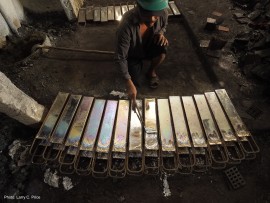Lead Smelting
Lead smelting is the industrial process of extracting lead metal from ores or mixed scrap, usually by heating, with added materials. In primary smelting, lead is separated from collected ore materials in a series of steps that separate lead from other metals and then purify the metal. Secondary lead smelting begins with scrap from worn-out, damaged or obsolete lead products, most often from used-lead acid batteries. During both primary and secondary processes, particulate matter, sulfur dioxide and other volatile compounds are emitted into the air. Waste in the forms of toxic wastewater and solid waste are also released.
According to the Pure Earth TSIP database, there are an estimated 1.1 million people at risk from lead smelting industries at more than 70 polluted sites around the world. This has resulted in a range of 1 million to 2.5 million DALYs where lead was identified as the primary pollutant.
Key Pollutants
Lead is the largest contributing contaminant from lead smelting industries, but mercury and cadmium have also been identified as major pollutants of concern. Cadmium, although not identified as a top pollutant within this report, was identified as one of the top six toxic threats of 2015. Of the million people at risk from lead smelting industries, 96 percent are related directly to lead, mercury or cadmium pollutants.
Smelting is a common industrial process for recovering metals from ores, and is used worldwide for copper and related metals and for zinc ores. All of these operations have the potential for emitting large quantities of toxic pollutants and are being included in TSIP surveys. However, there is not enough information to evaluate the full range of possible pollutants.
Exposure Pathways
Toxic chemicals from lead smelting processes can be emitted into the air, soil and water to directly affect human health and agricultural systems. During the smelting process, fumes and dust particles containing arsenic, antimony, cadmium, copper, mercury and lead can be emitted. These particles can settle in soil, to accumulate and possible impact surface and groundwater. Improperly disposed wastewater can also leach into drinking water and agricultural systems to impact food sources and negatively affect human health1




